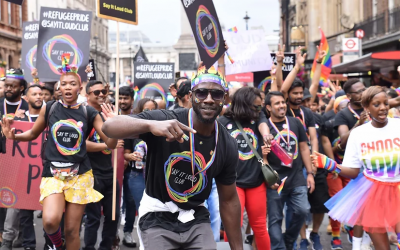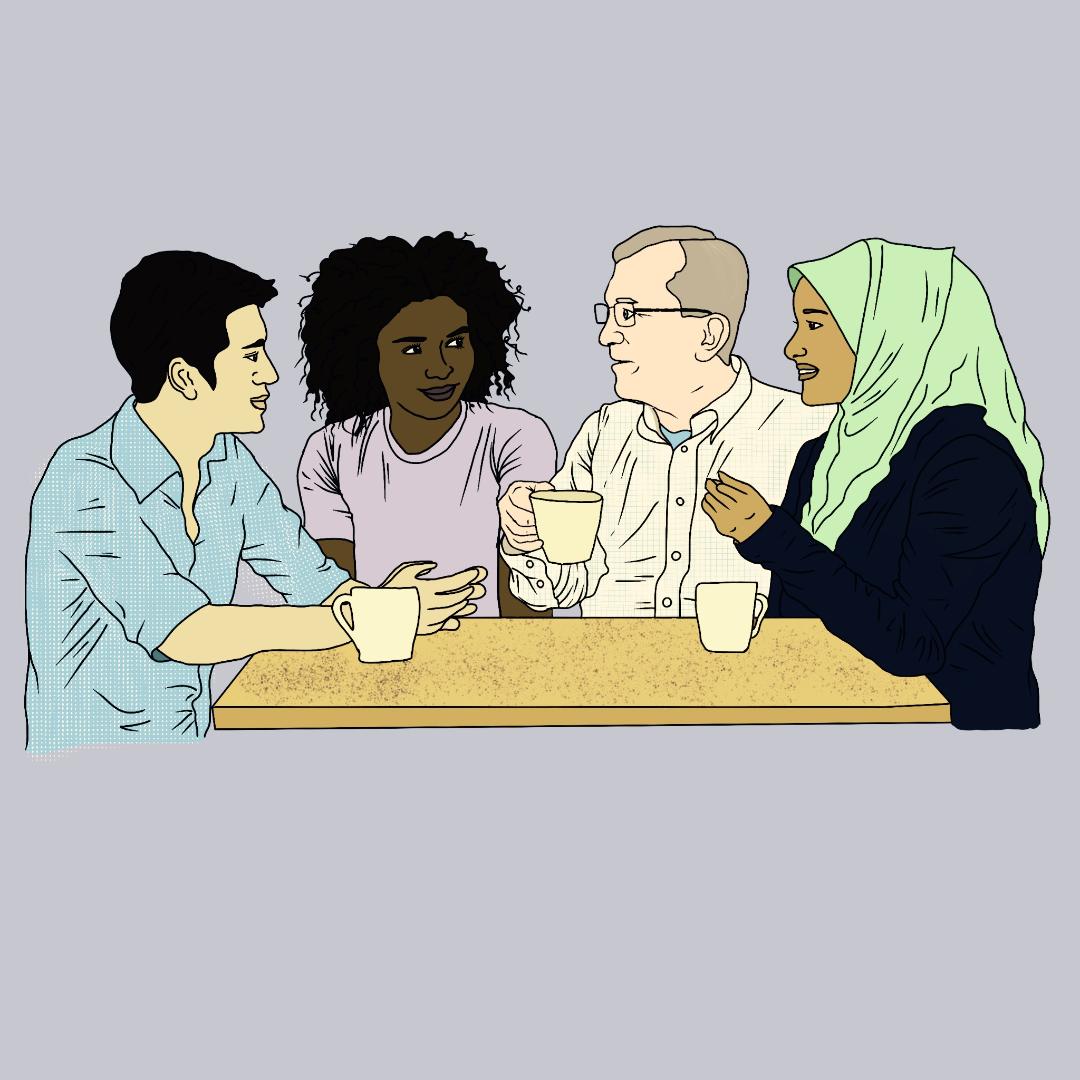Available at: Hear Our Stories \ Support Us
Review by Alison Hramiak
A moving and inspiring book, literally, from cover to cover. The front cover, created by the artist, Sophie MacKenzie, based on a concept by Kosta Eleftheriadis, is a beautiful way to start the book showing, the authors from the anthology ‘watering a bed of flowers from where people are emerging to make the journey from their homeland’. This is a skillful metaphor, realised in an image to encourage the reader to explore further.
It is followed by a dedication on the next page that concisely describes , the why and how this collection came about, ‘lest we forget’. The foreword, by Teresa Norman, is well worth a read too. It v carefully explains the reasons behind the book, giving an insight into the structure of it; the different chapters, ‘represent the different stages migrants face when coming to the United Kingdom’. These stages culminate in a final chapter with a collection of pieces that ably demonstrate how migrants have a relationship ‘with two cultures in two different countries’. A very fitting way to end the book.
The bit that stood out for me in the introduction to the anthology by Lord Alf Dubs, was his ‘belief in the power of storytelling’ as a way of reaching out to migrants who have stories to tell, and how this allows us to see through their eyes, and to better understand their situations. This does, as Lord Dubs says, ‘gives us questions to make us think’, something that these authors in this collection have undeniably achieved.
Here are some of my favourites, (there are so many to chose from) from the five different chapters, which will whet your appetite for more. Each chapter has its own introduction written by people with very personal and relevant experiences to share; each introduction lays the foundations for the chapter. For each of these pieces, there is a short biography of the author that sets the context of the piece they have written. This allows the reader to better visualise, the author’s context, and why they wrote what they did.
Chapter 1: The Journey
This focuses on the journey undertaken by migrants, and holds a variety of writing that keeps the reader engaged and drawn into different events. For example, you can feel the anguish in Michael Ndoun’s words in the poem, ‘Survivor’s Plea’ on p15 despite the positive ending to his poem:
‘Waiting for the sun, a chance at a new day.
Worth living.’
Abida Akram’s words in the poem, ‘The Journey (1964)’ on p19, leave you with an uplift when describing their experience of snow:
‘Melting, cold pieces
of soft cotton falling from a slate-grey sky,
`three months later,
made me laugh with wonder.
A year later, I found my voice again.’
Both these pieces, for me, balance out the heart rending words in pieces like Yousef’s prose on p21, and which leaves one with the message that these stories continue, ‘day in and day out’.
There is a resonanc, in the connection between the different poets, who, having travelled from warm dry places, find themselves in a cold wet England where they speak of ‘foreign rain’, a resonance borne of the way the rain is used as a metaphor for difference, such as in Morshed Akhtar’s words on p27, taken from the poem, ‘Even Rain has an Identity’:
So, this rain remains foreign to me with a strong identity.
So, even rains have an identity, do they?
What is my identity then, in this land?
But does the rain also have a race?
Chapter 2 Granted
This chapter describes what happens to refugees once they arrive in the United Kingdom. Frank’s story (p37) is particularly moving, with its practical details of the day-to-day existence in hostels. His words also reverberate with Ruth’s story on p53 as she describes the difficulties with common daily situations. Compare these to the very real place described in Loraine Masiya Mponela’s poem ‘I Own Nothing’ on p49 which shrewdly and starkly highlights how:
‘the stroke of a pen can take it all away’
The repeated line:
‘breaks my peace’
Echoes through the poem and in the mind of the reader, leaving one mindful of how very fragile the existence is for refugees.
Chapter 3 Discrimination
Reading about the discrimination migrants face, I found myself ashamed to be linked to the (probably, arguably?) white people judging, without thought or feeling, those who are different from them, as portrayed in these very painful pieces. Read, for example, Michael Ndoun’s final poem on p73, and unearth such sadness in his words, and such anger intelligently applied to poetry in the lines of ‘Immigrant Blues’:
‘The shadows of my sorrow yearn for a better tomorrow
with less commotion.
My melanin dictates whether I’m an immigrant or an
expatriate in a land with more
right motion.’
This chapter is relatively short but packs a powerful punch.
Chapter 4 Making a Life
We get a different perspective here with an introduction by Prof. Jonathan Portes, an expert in economics and public policy at King’s College, London. It illuminates the lack of understanding of how migrants enhance our lives. ‘Girl like Me’ on p79, by Sonja Morgenstern is incredibly poignant, and brings to the fore how terribly divisive Brexit was. For me, and at the risk of being too partisan, this should be a mandatory read for anyone who voted to leave Europe, (but maybe I’m being a tad unbalanced here?).
On pages 83 to 86 we get a child’s eye view from Erin Bresler of what it means to be taken to a different land, with no say in the matter. As a child myself, I moved from Halifax to a village south of Huddersfield, (all of 15 miles) because my parents needed to find work. I found it difficult as a 10-year-old to adapt to my new school, with its different accents and different dialects, (and we were still in West Yorkshire – we hadn’t even moved out of the county!). I still felt like a stranger in a strange land, and it took a while to adapt, and to forgive my parents. Reading these pieces in Chapter 4, makes one respect and admire the authors of these stories even more, when compared with them, my ‘move’ seems trivial. If I found it difficult without leaving my ‘shire’, then think how difficult it must be for those who travel thousands of miles to find a new home.
Chapter 5, Relationship with your country of origin
This chapter is a collection of writing that brings about a wonderfully fitting way to end this book, telling of, in many cases, journey’s that are yet to be completed. This is a chapter of great contrasts in terms of where the stories originate from and in how they are told. They speak of gain and loss of difference and similarity, demonstrating that there is more that connects us than divides, something that is reflected deeply in this chapter. Read how, on p142, Susan Ozer describes being ‘back in this beautiful green country called England’ that makes her’ heart jump when the plane emerges from the clouds’. Compare this with Goody’s determination to keep his Punjabi heritage on p143, who speaks of how she will keep both cultures:
‘Alongside being British,
I won’t take the Punjab
Out of my bones’
I particularly liked Erica Pham’s poem, Growing Up ‘Different’ to my Mum, (p145) which speaks of the loss of her cultural identity and how it ‘runs deeper than mere speech and language’, weaving this theme to describe the sacrifices her mum made in the, (very moving) last few lines on p146.
And finally
This book takes you on a journey that is ongoing, and one which raises more questions than it answers. It enables the reader to better understand people, to imagine wearing their shoes. In doing so, it might help us to create a better world. With this in mind I will leave you with Inna Martinova’s words from her poem ‘In Britain’ on p104:
Carrying my longing through the years
I will walk for many more years.
I’ll seal my doubts in verse
and with a smile on my face, I will learn this world.’




